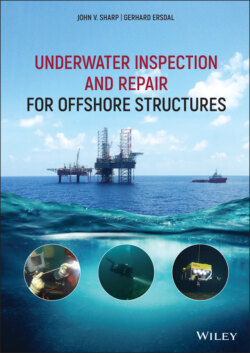Читать книгу Underwater Inspection and Repair for Offshore Structures - Gerhard Ersdal - Страница 19
1.4 Overview of this Book
ОглавлениеIn this book the important issues discussed so far are addressed by the following topics as indicated in Figure 6:
regulatory requirements for inspection and repair (Chapter 2);
where and when a structural inspection is needed (Chapter 6);
what tools and methods can be used to inspect structures and how inspection tools are deployed (Chapter 4);
types of damage that are found on offshore structures (Chapter 3);
what tools and methods can be used to monitor structures (Chapter 5);
how is the information maintained about the design, fabrication and installation in addition to the history of operation and inspection results (Chapter 6.1.5);
when is an anomaly in a structure acceptable and when is mitigation or repair needed (Chapter 7); and
which repair schemes are appropriate and what is the strength and fatigue life of a repaired component (Chapter 8).
Figure 6 The management process for safe operation by inspection and mitigation.
In all these areas, the book aims to provide an overview of previous studies relevant to each topic along with what is considered good practice.
An earlier book by Ersdal, Sharp and Stacey (Ersdal et al. 2019) addressed the topic of ageing and life extension of offshore structures, which provides a useful addition to this book. The main types of changes identified in this previous book are:
physical changes (ageing, degradation, loading, etc.);
technological changes (including compatibility and obsolescence);
changes to knowledge and safety requirements; and
structural information changes (e.g., accumulation of inspection data, loss of design data).
The focus of this book is on physical changes. However, the additional changes will also influence the safety of a structural system.
As already mentioned, there has been a significant amount of previous work, including research on each of these key elements related to inspection, evaluation and repair for offshore structures, which are in some cases unavailable to the public. These key reports have been reviewed by the authors and presented in this book with the aim of providing the reader with an awareness of this background, which is important in the context of structural integrity management.
It is important to recognize that choices made in the design will significantly influence inspection and repair of an offshore structure (the need for inspection and how it can be performed). Such choices include:
the existence of any preinstalled monitoring systems;
access for inspection and repair;
cathodic protection system design and coatings;
material selection;
design margins, design fatigue life, robustness, redundancy; and
operational restrictions given by the design.
In addition, the book will discuss the competency requirements for inspectors, structural engineers involved in integrity management and the organisational requirement for integrity management.
